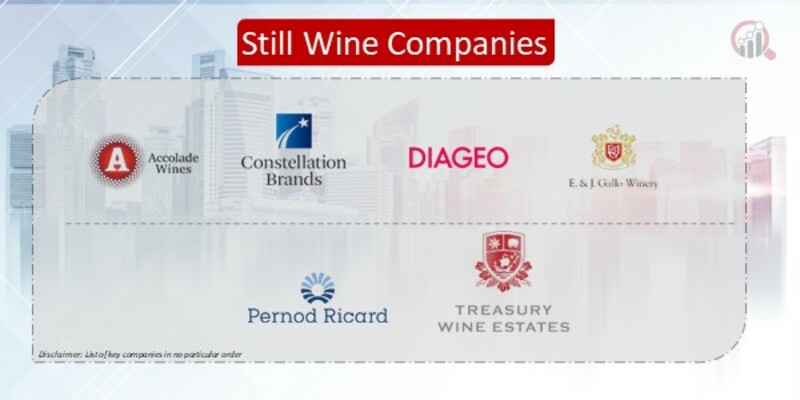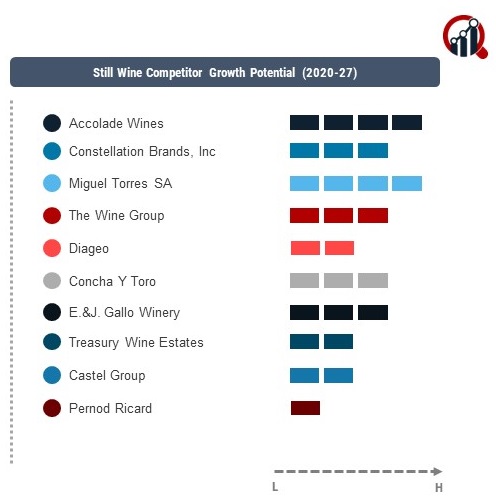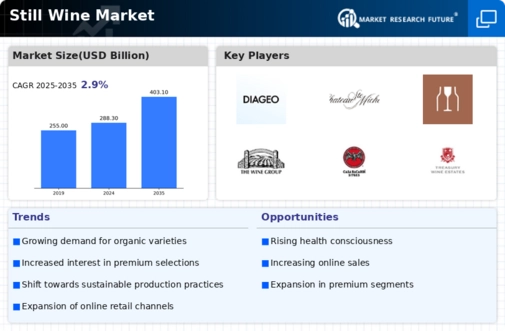Top Industry Leaders in the Still Wine Market
 The still wine market is a highly competitive industry characterized by numerous key players, each employing diverse strategies to gain a stronghold in the market. The key players in the still wine market are global giants, regional players, and emerging companies, all vying for market share. Understanding the competitive landscape is crucial for stakeholders to make informed decisions and navigate the dynamic nature of the industry.
The still wine market is a highly competitive industry characterized by numerous key players, each employing diverse strategies to gain a stronghold in the market. The key players in the still wine market are global giants, regional players, and emerging companies, all vying for market share. Understanding the competitive landscape is crucial for stakeholders to make informed decisions and navigate the dynamic nature of the industry.
List of Key Players:
- Accolade Wines (Australia)
- Constellation Brands, Inc. (US)
- Miguel Torres SA (Spain)
- The Wine Group (California)
- Diageo (UK)
- Concha y Toro (Chile)
- E&J. Gallo Winery (US)
- Treasury Wine Estates (Australia)
- Castel Group (France)
- Pernod Ricard (France)
Strategies Adopted:
Product Innovation: Key players consistently introduce new and innovative still wine products to meet evolving consumer preferences and stay ahead in the competitive landscape.
Market Expansion: Many companies are expanding their market reach by entering new geographical regions, tapping into emerging markets with growth potential.
Brand Positioning: Effective branding and marketing strategies are employed to establish a strong brand presence and differentiate products in a crowded market.
Sustainability Initiatives: Companies are increasingly adopting sustainable practices in vineyard management and winemaking processes to appeal to environmentally conscious consumers.
Partnerships and Collaborations: Collaborative efforts with distributors, retailers, and other stakeholders are common strategies to enhance distribution networks and market reach.
Market Share Analysis:
Brand Equity: The strength and recognition of a brand play a crucial role in determining market share, with consumers often preferring established and reputable brands.
Distribution Network: The effectiveness of a company's distribution network influences its market share, ensuring products are readily available to consumers in various regions.
Product Portfolio: Diversification of product offerings, including different varietals, wine styles, and price points, contributes to capturing a broader market share.
Geographical Presence: Companies with a widespread geographical presence have a competitive advantage in catering to diverse consumer preferences and market demands.
Consumer Preferences: Understanding and adapting to changing consumer preferences is vital for gaining and maintaining market share in the still wine industry.
New and Emerging Companies:
Several new and emerging companies are making their mark in the still wine market, bringing fresh perspectives and innovative approaches. These companies often focus on niche markets, organic products, or unique winemaking techniques to differentiate themselves from established players.
Industry News and Current Company Developments:
Recent industry news and company developments indicate the dynamic nature of the still wine market. Mergers and acquisitions, changes in leadership, and partnerships are common occurrences, shaping the competitive landscape.
Investment Trends:
Investment trends in the still wine market reflect the industry's growth potential and opportunities. Notable trends include investments in sustainable practices, technology integration in winemaking processes, and acquisitions to expand market presence.
Competitive Scenario:
The still wine market's overall competitive scenario is characterized by intense rivalry among key players, constant innovation, and a focus on meeting consumer demands. Market dynamics are influenced by factors such as economic conditions, regulatory changes, and evolving consumer preferences, creating a challenging yet dynamic environment.
Recent Developments
The still wine market witnessed several noteworthy developments. Many key players introduced new product lines, leveraging consumer trends toward health and wellness by incorporating low-alcohol and organic options into their portfolios. Additionally, strategic partnerships and collaborations between wineries and technology companies emerged, aiming to enhance distribution channels and improve customer engagement through online platforms.
Sustainability remained a key focus, with companies implementing eco-friendly packaging solutions and adopting renewable energy sources in vineyard operations. Market consolidation continued, with a few mergers and acquisitions reshaping the competitive landscape, allowing companies to strengthen their market positions and achieve economies of scale.
In summary The still wine market remains highly competitive, with key players employing diverse strategies to gain an edge in a rapidly evolving industry. The emphasis on innovation, sustainability, and strategic collaborations underscores the industry's commitment to meeting consumer expectations and staying ahead of market trends.










